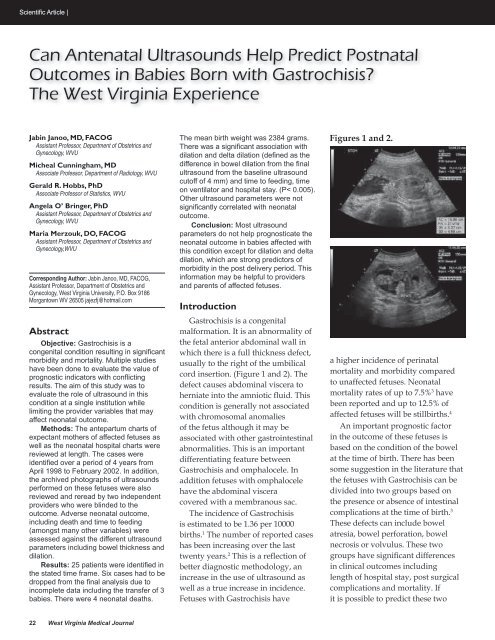March/April - West Virginia State Medical Association
March/April - West Virginia State Medical Association
March/April - West Virginia State Medical Association
You also want an ePaper? Increase the reach of your titles
YUMPU automatically turns print PDFs into web optimized ePapers that Google loves.
Scientific Article |<br />
Can Antenatal Ultrasounds Help Predict Postnatal<br />
Outcomes in Babies Born with Gastrochisis?<br />
The <strong>West</strong> <strong>Virginia</strong> Experience<br />
Jabin Janoo, MD, FACOG<br />
Assistant Professor, Department of Obstetrics and<br />
Gynecology, WVU<br />
Micheal Cunningham, MD<br />
Associate Professor, Department of Radiology, WVU<br />
Gerald R. Hobbs, PhD<br />
Associate Professor of Statistics, WVU<br />
Angela O’ Bringer, PhD<br />
Assistant Professor, Department of Obstetrics and<br />
Gynecology, WVU<br />
Maria Merzouk, DO, FACOG<br />
Assistant Professor, Department of Obstetrics and<br />
Gynecology,WVU<br />
Corresponding Author: Jabin Janoo, MD, FACOG,<br />
Assistant Professor, Department of Obstetrics and<br />
Gynecology, <strong>West</strong> <strong>Virginia</strong> University, P.O. Box 9186<br />
Morgantown WV 26505 jajezfj@hotmail.com<br />
Abstract<br />
Objective: Gastrochisis is a<br />
congenital condition resulting in significant<br />
morbidity and mortality. Multiple studies<br />
have been done to evaluate the value of<br />
prognostic indicators with conflicting<br />
results. The aim of this study was to<br />
evaluate the role of ultrasound in this<br />
condition at a single institution while<br />
limiting the provider variables that may<br />
affect neonatal outcome.<br />
Methods: The antepartum charts of<br />
expectant mothers of affected fetuses as<br />
well as the neonatal hospital charts were<br />
reviewed at length. The cases were<br />
identified over a period of 4 years from<br />
<strong>April</strong> 1998 to February 2002. In addition,<br />
the archived photographs of ultrasounds<br />
performed on these fetuses were also<br />
reviewed and reread by two independent<br />
providers who were blinded to the<br />
outcome. Adverse neonatal outcome,<br />
including death and time to feeding<br />
(amongst many other variables) were<br />
assessed against the different ultrasound<br />
parameters including bowel thickness and<br />
dilation.<br />
Results: 25 patients were identified in<br />
the stated time frame. Six cases had to be<br />
dropped from the final analysis due to<br />
incomplete data including the transfer of 3<br />
babies. There were 4 neonatal deaths.<br />
The mean birth weight was 2384 grams.<br />
There was a significant association with<br />
dilation and delta dilation (defined as the<br />
difference in bowel dilation from the final<br />
ultrasound from the baseline ultrasound<br />
cutoff of 4 mm) and time to feeding, time<br />
on ventilator and hospital stay. (P< 0.005).<br />
Other ultrasound parameters were not<br />
significantly correlated with neonatal<br />
outcome.<br />
Conclusion: Most ultrasound<br />
parameters do not help prognosticate the<br />
neonatal outcome in babies affected with<br />
this condition except for dilation and delta<br />
dilation, which are strong predictors of<br />
morbidity in the post delivery period. This<br />
information may be helpful to providers<br />
and parents of affected fetuses.<br />
Introduction<br />
Gastrochisis is a congenital<br />
malformation. It is an abnormality of<br />
the fetal anterior abdominal wall in<br />
which there is a full thickness defect,<br />
usually to the right of the umbilical<br />
cord insertion. (Figure 1 and 2). The<br />
defect causes abdominal viscera to<br />
herniate into the amniotic fluid. This<br />
condition is generally not associated<br />
with chromosomal anomalies<br />
of the fetus although it may be<br />
associated with other gastrointestinal<br />
abnormalities. This is an important<br />
differentiating feature between<br />
Gastrochisis and omphalocele. In<br />
addition fetuses with omphalocele<br />
have the abdominal viscera<br />
covered with a membranous sac.<br />
The incidence of Gastrochisis<br />
is estimated to be 1.36 per 10000<br />
births. 1 The number of reported cases<br />
has been increasing over the last<br />
twenty years. 2 This is a reflection of<br />
better diagnostic methodology, an<br />
increase in the use of ultrasound as<br />
well as a true increase in incidence.<br />
Fetuses with Gastrochisis have<br />
Figures 1 and 2.<br />
a higher incidence of perinatal<br />
mortality and morbidity compared<br />
to unaffected fetuses. Neonatal<br />
mortality rates of up to 7.5% 3 have<br />
been reported and up to 12.5% of<br />
affected fetuses will be stillbirths. 4<br />
An important prognostic factor<br />
in the outcome of these fetuses is<br />
based on the condition of the bowel<br />
at the time of birth. There has been<br />
some suggestion in the literature that<br />
the fetuses with Gastrochisis can be<br />
divided into two groups based on<br />
the presence or absence of intestinal<br />
complications at the time of birth. 3<br />
These defects can include bowel<br />
atresia, bowel perforation, bowel<br />
necrosis or volvulus. These two<br />
groups have significant differences<br />
in clinical outcomes including<br />
length of hospital stay, post surgical<br />
complications and mortality. If<br />
it is possible to predict these two<br />
22 <strong>West</strong> <strong>Virginia</strong> <strong>Medical</strong> Journal















